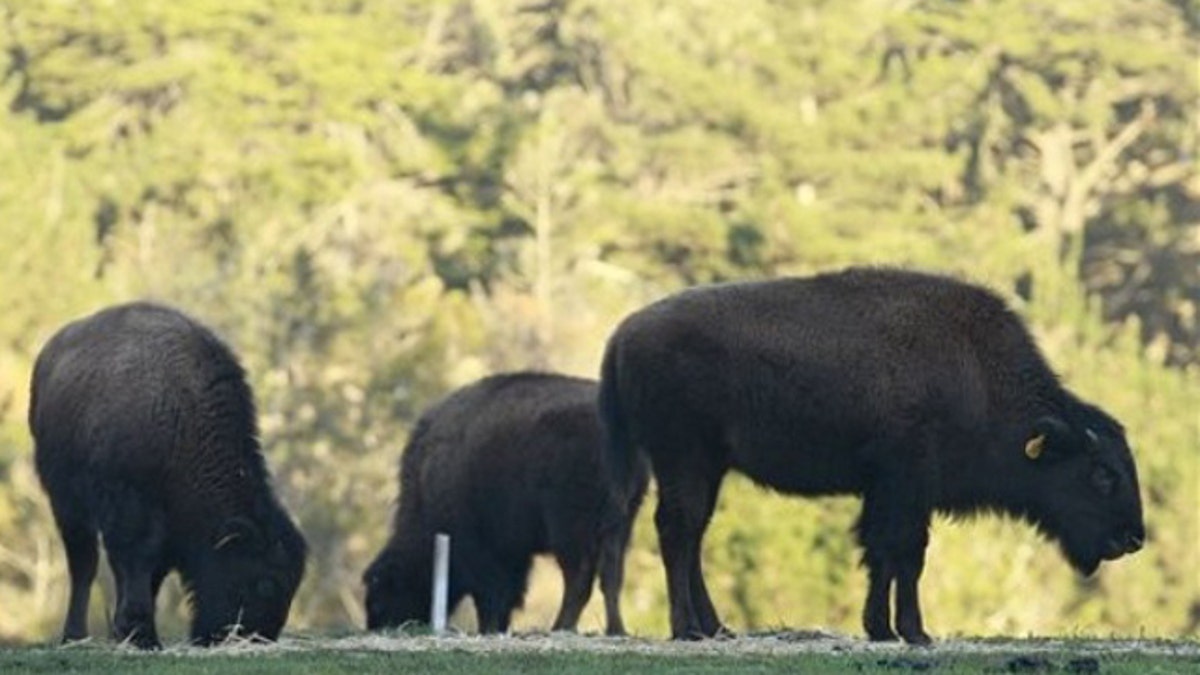
Young bison are shown at the Golden Gate Park Buffalo Paddock in San Francisco, Thursday, Jan. 5, 2012. San Francisco officials are blaming an off-leash dog for the death of a baby bison found injured in its enclosure at Golden Gate Park. The San Francisco parks department says the bison was found with a laceration on its side and three broken ribs Wednesday morning. (AP Photo/Jeff Chiu) (AP)
BILLINGS, Montana – Sixty-four bison from Yellowstone National Park were set to arrive Monday on an American Indian reservation under a long-stalled plan to repopulate parts of the U.S. West with the iconic animals.
Tribal and state officials signed an agreement late Friday allowing the transfer to take place, said Robert Magnan with the Fort Peck Fish and Game Department in Montana.
The shipment date was kept quiet until it was under way to avoid a court injunction, he said. A group of Montana landowners and property groups filed a lawsuit in state district court in January seeking to stop the transfer.
Several prior attempts to relocate the animals failed because of opposition from cattle producers and difficulty finding public or tribal land suitable for the bison.
State wildlife officials have said the relocation may help answer the question of whether the species can be reintroduced to some public lands in Montana where they once roamed freely. Overhunting in the 19th century wiped out vast herds of millions of bison that once roamed across most of North America.
Montana Gov. Brian Schweitzer said Monday that the relocation of bison to Fort Peck was a first step in efforts to bring the animals back across a larger landscape.
"This is where we're going to establish the beachhead of genetically pure bison that will be available as their numbers grow to go to other reservations and other public lands all across the West," Schweitzer said.
The animals have been confined to quarantine for several years. They were captured leaving the park during their winter migration and tested extensively to make sure they were free of brucellosis. That disease, which can cause pregnant animals to abort their young, was for many years the primary argument for preventing Yellowstone bison from roaming freely outside the park.
But critics of the relocation have lingering worries about bison competing with cattle for rangeland.
State Sen. Rick Ripley, a plaintiff in the landowners' lawsuit, criticized Monday's move and said it was in defiance of a law passed last year that required officials to come up with a statewide bison management plan before moving the animals.
"They just seem to think they are above the law," Ripley said.
The 64 bison and their offspring will remain inside a fenced compound on the reservation and should not cause any problems for the neighbors of the Assiniboine and Sioux tribes, Magnan said.
The tribes already have about 200 bison in a commercial herd that are used for meat and hunting. But those animals are not genetically pure like the Yellowstone bison.
"One of the main things we're trying to do is preserve the genetic integrity of these animals," Magnan said. "The cultural links from those genetics will be the closest to the bison of our ancestors."
